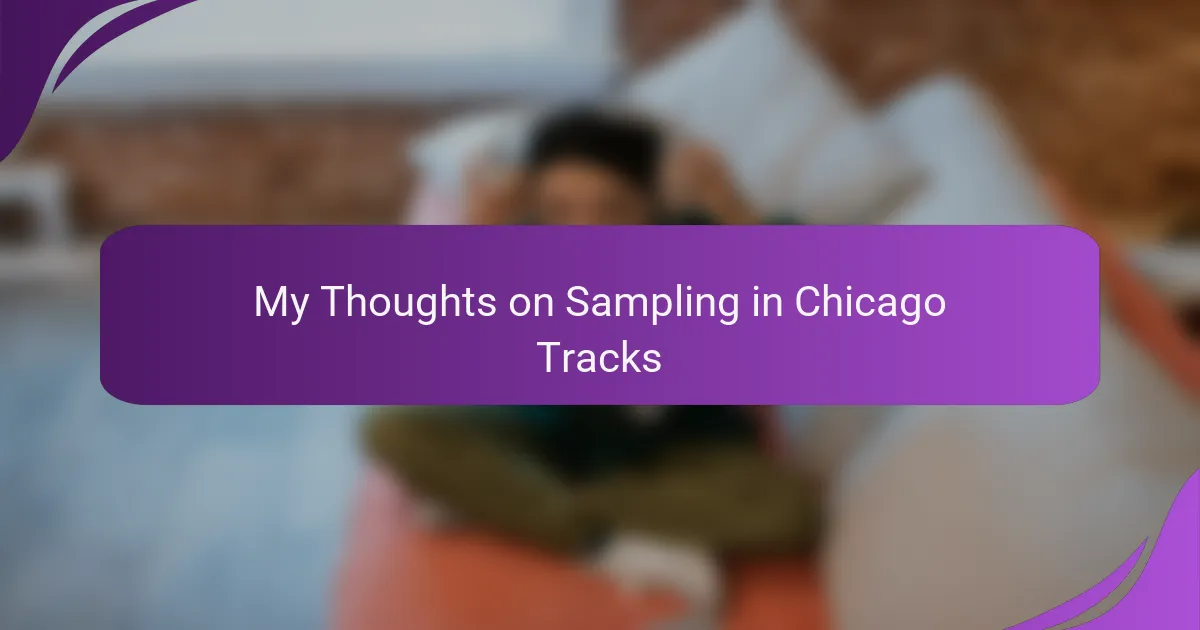Key takeaways
- Chicago rap music reflects the city’s diverse culture, with artists drawing from various experiences and backgrounds.
- Sampling is a crucial technique in rap, allowing artists to honor past influences while creating innovative new sounds.
- Notable Chicago tracks like “G.O.M.D.” by J. Cole and “I Don’t Like” by Chief Keef exemplify how sampling enhances storytelling and connects generations.
- The emotional and narrative depth achieved through sampling fosters a sense of community among listeners and artists alike.

Overview of Chicago Rap Music
Chicago rap music has always been a vibrant reflection of the city’s rich cultural tapestry. From the gritty streets of the South Side to the artistic enclaves of the North, each artist draws inspiration from their surroundings, creating a sound that is uniquely Chicago. Listening to tracks that weave narratives of struggle, triumph, and resilience, I often find myself pondering how these experiences shape the music we hear.
The emergence of drill music in the early 2010s marked a pivotal moment in Chicago’s rap scene, introducing a rawness and intensity that captivated listeners nationwide. I vividly remember the first time I heard a drill track; it was like stepping into a different world, one where every beat and lyric told a story of real-life challenges. How do these artists manage to express such depth with just a few lines? It’s incredible how they distill complex emotions into powerful verses.
Beyond drill, Chicago rap encompasses a variety of styles and influences that have contributed to its evolving identity. Artists like Chance the Rapper and Common showcase the diverse narrative possibilities beyond the streets, blending genres and experimenting with sounds. It’s this rich diversity that makes Chicago’s hip-hop scene so captivating—there’s truly something for everyone, and each new artist brings their own flavor to the mix.
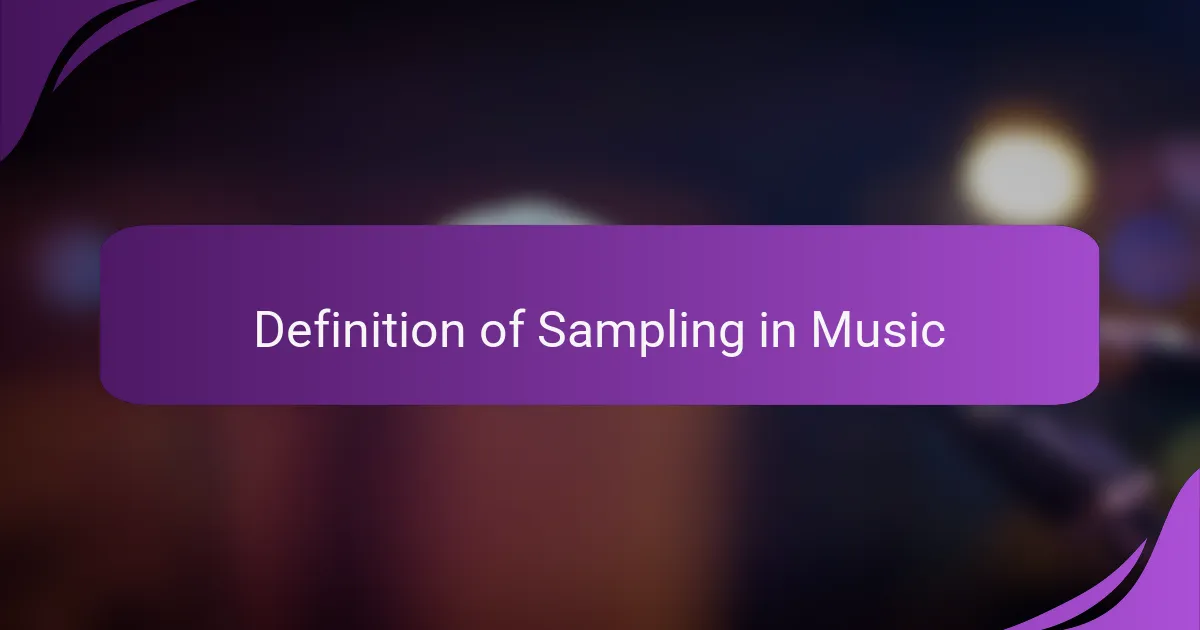
Definition of Sampling in Music
Sampling in music is the practice of taking a portion of a sound recording and reusing it in a different song or piece of music. It’s fascinating how this technique can pay homage to past artists while also blending new sounds to create something fresh and innovative. I remember the first time I heard a classic loop from a song I loved suddenly woven into a contemporary rap track— it truly felt like a bridge connecting different generations.
In the realm of Chicago rap, sampling is particularly significant. Many artists in the city utilize this technique to showcase their roots and influences, often leading to an emotional listening experience. The careful selection of snippets from jazz, soul, and funk not only enriches the track but also tells a deeper story about the artist’s journey.
- Sampling transforms old sounds into new narratives.
- It allows artists to pay tribute to their influences.
- Chicago rap artists skillfully blend various genres through sampling.
- This technique can evoke strong emotional responses from listeners.
- Sampling creates a sense of community by connecting past and present.
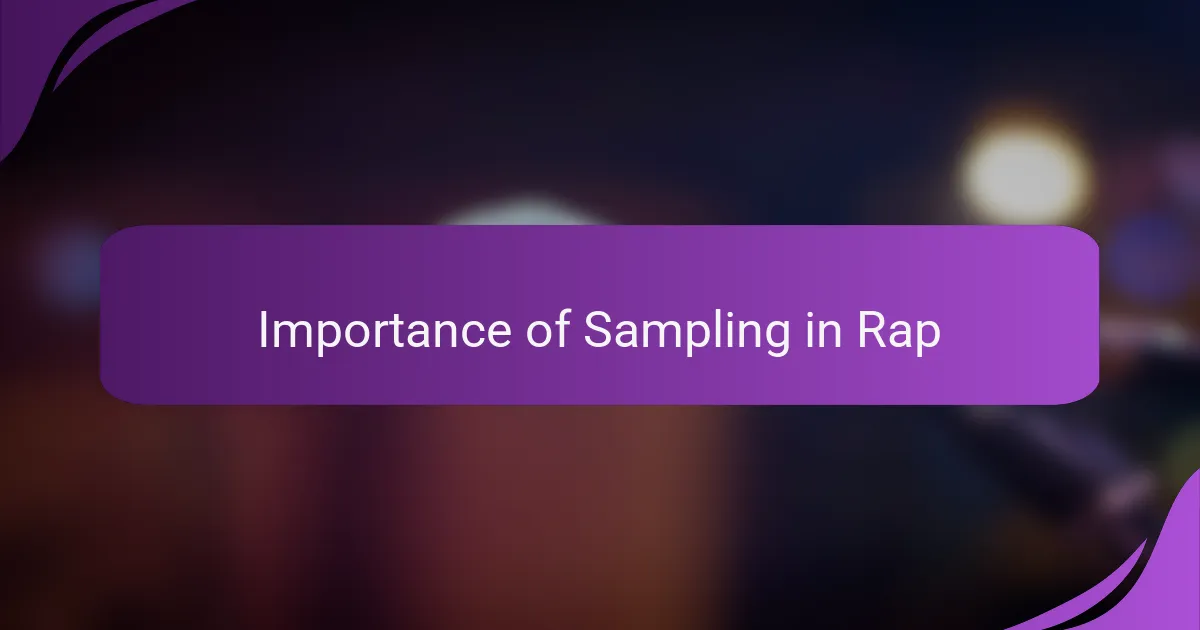
Importance of Sampling in Rap
Sampling in rap is crucial because it connects the present to the past, allowing artists to pay homage to musical influences while creating something fresh. I remember the first time I heard a classic soul sample transformed into a hard-hitting rap track; it made me appreciate the artistry behind both the original song and the new creation. It’s fascinating how a simple loop can evoke powerful emotions and memories, proving that sampling can breathe new life into music.
When I think of Chicago rap, I see sampling as a bridge between generations. Tracks featuring samples often tell a story, reinforcing the depth and culture embedded in the city. The way artists weave together various styles and sounds creates a vibrant tapestry that represents the essence of Chicago’s rich musical landscape.
Here’s a quick comparison on the role of sampling in different music genres:
| Genre | Role of Sampling |
|---|---|
| Rap | Connects history with modern sounds; allows for creative reinterpretation. |
| Pop | Enhances catchiness; often used to attract a wider audience. |
| Electronic | Serves as a foundational element; often manipulates and reimagines existing music. |
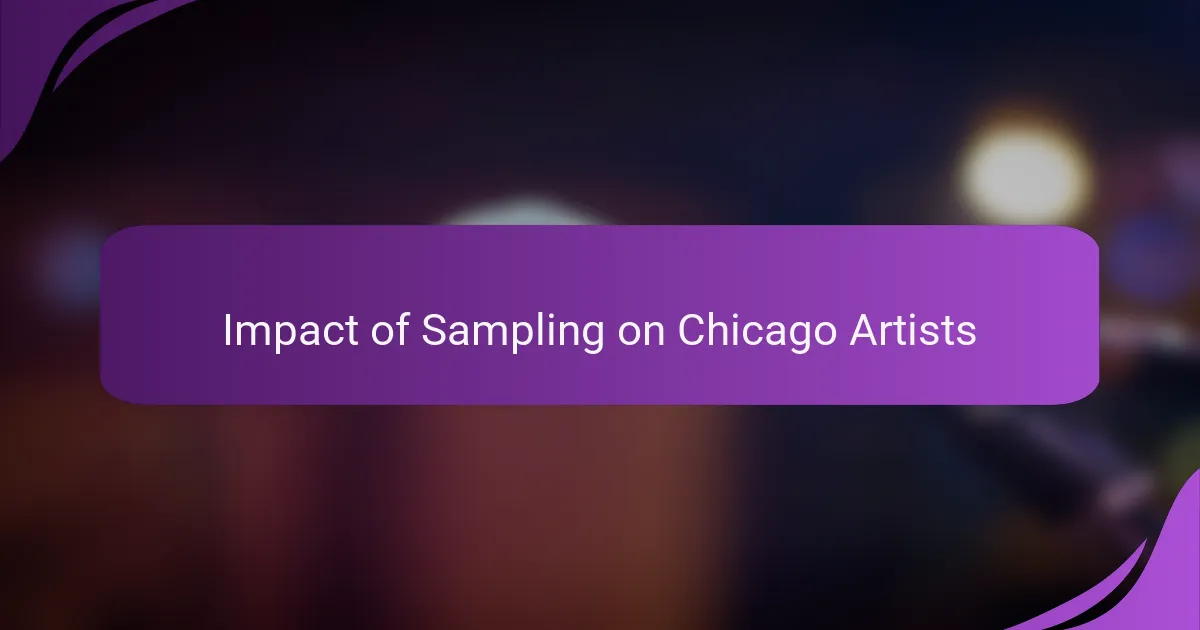
Impact of Sampling on Chicago Artists
Sampling has played a pivotal role in shaping the sound of Chicago rap. Many artists, including legends like Kanye West and Common, have used samples to bridge different musical eras, creating a rich tapestry of sounds. I remember the first time I heard a track that flipped an old soul sample; it was like experiencing a new dimension of music that instantly resonated with my feelings and memories.
The impact of sampling on Chicago artists goes beyond mere nostalgia. It serves as a storytelling tool that connects listeners to deeper cultural and social themes. Artists can reference the past while making bold statements about the present. Here are some ways sampling influences Chicago’s rap scene:
- Cultural Connection: Samples often evoke shared memories and emotions among listeners.
- Musical Innovation: Artists frequently blend genres, creating unique sounds that reflect Chicago’s diverse musical landscape.
- Narrative Depth: Sampling allows rappers to contextualize their lyrics, enriching their storytelling with historical or emotional layers.
- Community Upliftment: By sampling, artists pay homage to influences from their roots, celebrating and revitalizing local talent.
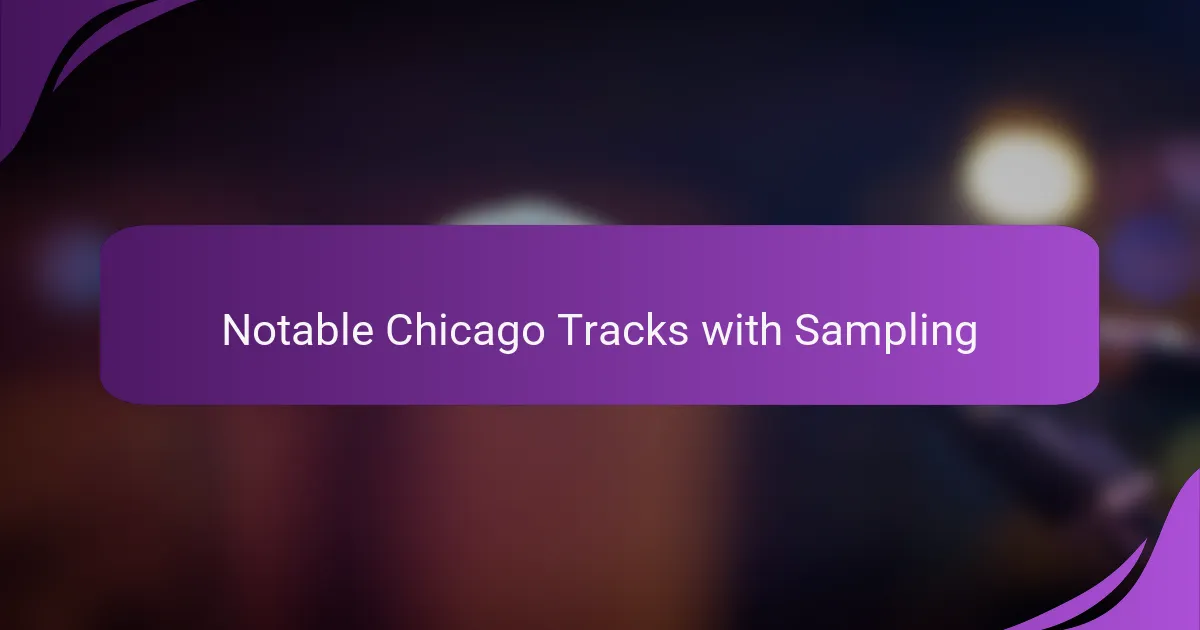
Notable Chicago Tracks with Sampling
Sampling is a vibrant aspect of Chicago’s rap scene, and several tracks stand out for their innovative use of samples. One notable example is “G.O.M.D.” by J. Cole, which features a soulful sample that adds depth to his narrative about identity and resilience. I remember the first time I heard it; the complex layering made me appreciate how sampling can elevate storytelling in music.
Another fantastic track is “I Don’t Like” by Chief Keef, which uses a sample from a classic song, infusing it with a raw energy that captures the essence of Chicago street life. Listening to it always transports me back to those gritty summer nights in the city when the beats were loud and the vibes were even louder. These songs illustrate how sampling not only pays homage to past music but also creates a bridge to new narratives in the present.
Here’s a comparison of notable tracks using sampling:
| Track | Artist |
|---|---|
| G.O.M.D. | J. Cole |
| I Don’t Like | Chief Keef |
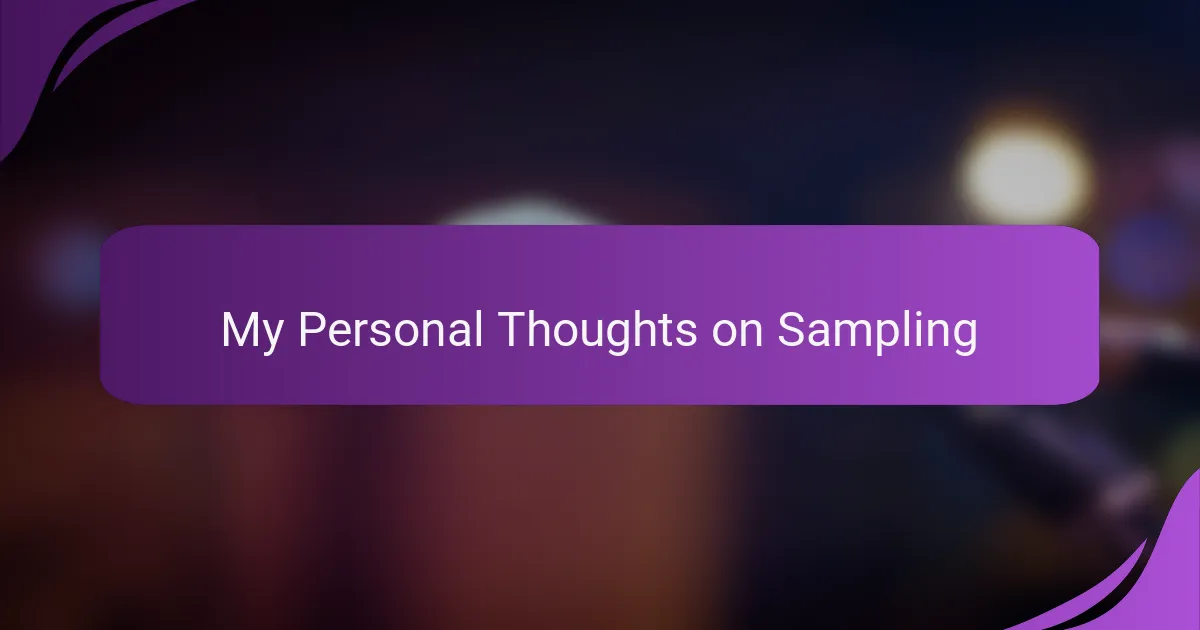
My Personal Thoughts on Sampling
Sampling holds a special place in my heart when it comes to Chicago rap music. I vividly recall the first time I heard a soulful loop woven into a contemporary beat; it felt like meeting an old friend in a new context. This moment transformed my appreciation for the artistry involved, as it highlighted how samples can evoke nostalgia while simultaneously pushing the music forward.
I often find myself wondering how artists choose which samples to incorporate. It’s not just about finding a catchy hook; it’s about the story behind the sound. When I listen to tracks that expertly blend genres, I can almost feel the artist’s journey through the notes they select. For instance, a well-placed jazz snippet can root the track in history while giving it a fresh, modern twist.
Through sampling, Chicago artists not only pay tribute to their influences but also craft a narrative that feels inherently connected to both the past and present. Each track tells a story, often resonating deeply with listeners like me who find threads of their own experiences woven into the music. It’s these layers of meaning that make sampling such a powerful tool, bridging generations and uniting communities through shared memories and emotions.
